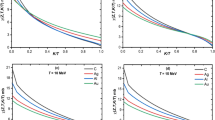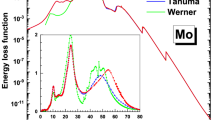Abstract
An algorithm for Monte Carlo simulation of bremsstrahlung emission by electrons based on the framework of SuperMC is presented in this paper with efficient and accurate methods to sample the angular distribution and energy of bremsstrahlung photons. The photon energy is sampled according to scaled energy-loss differential cross sections tabulated by Seltzer and Berger. A novel hybrid model for photon angular distribution by low- and high-energy incident electrons is developed. The model uses Tsai’s full form of angular distribution function with atomic form factors for high-energy incident electrons. For electrons of <500 keV, a simple efficient and accurate analytical distribution function is developed, using adjustable parameters determined from the fitting of numerical values of the shape functions tabulated by Kissel et al. The efficiency of sampling photon energy is 80%. Our angular sampling algorithm for high-energy electron bremsstrahlung based on Tsai distribution function is very efficient (sampling efficiency ~70%) in the useful photon energy range.








Similar content being viewed by others
References
F. Salvat, J.M. Fernández-Varea, J. Sempau et al., Monte Carlo simulation of bremsstrahlung emission by electrons. Radiat. Phys. Chem. 75, 1201–1219 (2006). doi:10.1016/j.radphyschem.2005.05.008
Y. Wu, J. Song, H. Zheng et al., CAD-based Monte Carlo program for integrated simulation of nuclear system SuperMC. Ann. Nucl. Energy 82, 161–168 (2015). doi:10.1016/j.anucene.2014.08.058
Y. Wu, CAD-based interface programs for fusion neutron transport simulation. Fusion Eng. Des. 84, 1987–1992 (2009). doi:10.1016/j.fusengdes.2008.12.041
Y. Li, L. Lu, A. Ding et al., Benchmarking of MCAM 4.0 with the ITER 3D model. Fusion Eng. Des. 82, 2861–2866 (2007). doi:10.1016/j.fusengdes.2008.12.041
Y. Wu, Z. Xie, U. Fischer, A discrete ordinates nodal method for one-dimensional neutron transport calculation in curvilinear geometries. Nucl. Sci. Eng. 133(3), 350–357 (1999)
Y. Wu, S. Zheng, X. Zhu et al., Conceptual design of the fusion-driven subcritical system FDS-I. Fusion Eng. Des. 81(Part B), 1305–1311 (2006). doi:10.1016/j.fusengdes.2005.10.015
Y. Wu, F.D.S. Team, Conceptual design of the China fusion power plant FDS-II. Fusion Eng. Des. 83(10–12), 1683–1689 (2008). doi:10.1016/j.fusengdes.2008.06.048
Y. Wu, F.D.S. Team, Fusion-based hydrogen production reactor and its material selection. J. Nucl. Mater. 386–388, 122–126 (2009). doi:10.1016/j.jnucmat.2008.12.075
Y. Wu, F.D.S. Team, Conceptual design and testing strategy of a dual functional Lithium-Lead test blanket module in ITER and EAST. Nucl. Fusion 47(11), 1533–1539 (2007)
Y. Wu, F.D.S. Team, Design analysis of the China dual-functional lithium lead (DFLL) test blanket module in ITER. Fusion Eng. Des. 82, 1893–1903 (2007). doi:10.1016/j.fusengdes.2007.08.012
Y. Wu, Progress in fusion-driven hybrid system studies in China. Fusion Eng. Des. 63–64, 73–80 (2002). doi:10.1016/S0920-3796(02)00239-9
Y. Wu, G. Song, R.F. Cao et al., Development of accurate/advanced radiotherapy treatment planning and quality assurance system (ARTS). Chin. Phys. C 32(Suppl.II), 177–182 (2008)
H.W. Koch, J.W. Motz, Bremsstrahlung cross section formulas and related data. Rev. Mod. Phys. 31, 920–955 (1959). doi:10.1103/RevModPhys.31.920
Y.S. Tsai, Pair production and bremsstrahlung of charged leptons. Rev. Mod. Phys. 46, 815–851 (1974). doi:10.1103/RevModPhys.46.815
A.F. Bielajew, M. Rahde, S.C. Chen. Improved bremsstrahlung photon angular sampling in EGS4 code system. NRC Ottawa, Canada, PIRS-0203R, (1989)
W.R. Nelson, H. Hirayama, D.W.O. Rogers. The EGS4 code system. Stanford Linear Accelerator Centre, Stanford. CA. Report SLAC-265, (1985)
E. Acosta, X. Llovet, F. Salvat, Monte Carlo simulation of bremsstrahlung emission by electrons. Appl. Phys. Lett. 80, 3228–3230 (2002). doi:10.1063/1.1473684
L. Kissel, C.A. Quarles, R.H. Pratt, Shape functions for atomic field bremsstrahlung from electrons of kinetic energy 1–500 keV on selected neutral atoms 1 ≤ Z ≤ 92. At. Data Nucl. Data Tables 28, 381–460 (1983). doi:10.1016/0092-640X(83)90001-3
H.K. Tseng, R.H. Pratt, C.M. Lee, Electron bremsstrahlung angular distribution in the 1–500 keV energy range. Phys. Rev. A 19, 187–195 (1979). doi:10.1103/PhysRevA.19.187
S. Agostinelli, J. Allison, K. Amako et al., Geant4—a simulation toolkit. Nucl. Instrum. Methods A 506, 250–303 (2003). doi:10.1016/S0168-9002(03)01368-8
P. Rodrigues, R. Moura, C. Ortigao et al., Geant 4 applications and developments for medical physics experiments. IEEE Trans. Nucl. Sci. 51, 1412–1419 (2004). doi:10.1109/TNS.2004.832314
I. Kawrakow, E. Mainegra-Hing, D.W.O. Rogers et al., The EGSnrc code system. Monte Carlo simulation of electron and photon transport. NRCC Report PIRS-701 (2011)
S.M. Seltzer, M.J. Berger, Bremsstrahlung energy spectra from electrons with kinetic energy 1 keV–10 GeV incident on screened nuclei and orbital electrons of neutral atoms with Z = 1–100. At. Data Nucl. Data Tables 35, 345–418 (1986). doi:10.1016/0092-640X(86)90014-8
H. Davies, H.A. Bethe, L.C. Maximon, Theory of bremsstrahlung and pair production. II. Integral cross section for pair production. Phys. Rev. 93, 788–795 (1954). doi:10.1103/PhysRev.93.788
H. Olsen, L.C. Maximon, Photon and electron polarization in high-energy bremsstrahlung and pair production with screening. Phys. Rev. 114, 887–904 (1989). doi:10.1103/PhysRev.114.887
H. Hirayama, Y. Namito, A.F. Bielajew et al., The EGS5 code system. Stanford Linear Accelerator Centre, Stanford. CA. Report SLAC-R-730, (2015)
Acknowledgements
The authors would like to show their great appreciation to other members of FDS Team for their support and contribution to this research.
Author information
Authors and Affiliations
Corresponding author
Additional information
This work was supported by the National Natural Science Foundation of China (No. 81101132 and 11305203), the Strategic Priority Research Program of Chinese Academy of Sciences (No. XDA03040000) and the Natural Science Foundation of Anhui Province of China (No. 1508085QH180).
Rights and permissions
About this article
Cite this article
Wasaye, M.A., Wang, H. & He, P. An algorithm for Monte Carlo simulation of bremsstrahlung emission by electrons. NUCL SCI TECH 28, 71 (2017). https://doi.org/10.1007/s41365-017-0218-7
Received:
Revised:
Accepted:
Published:
DOI: https://doi.org/10.1007/s41365-017-0218-7




